Reconnecting the Landscape in Historical Cities, Conceptual Analysis of Historic Urban Landscape Approach in Iran
Behrang Bahrami , Firoozeh Agha and Ebrahimi Samani
1
Faculty of Environment,
University of Tehran,
Tehran,
Iran
DOI: http://dx.doi.org/10.12944/CWE.10.2.09
Historic Urban Landscape is the consequence of dynamic interrelationships between physical, ecological, and cultural factors in a causality based dynamic system. In recent years, urban development plans, inattentive to ecological and historical structures of landscape, have led to segregation of urban values. At a time of rapid urbanization, the conservation of historic cities is one of the most urgent challenges. Reviewing the principles and policies has led to a theoretical framework, based on approved approaches toward the subject for conservative planning. Planning in HUL, requires information which should be identified through scientific survey methods, regulations and principles, tools and procedures and also executive guidelines based on conservation. This research has investigated the historical and natural structure of Isfahan’s urban landscape in Iran. Analyses found improper urban development as the cause for disconnections in the HUL of Isfahan; providing effective theoretical framework that helps presenting a conservation plan for this historical city.
Copy the following to cite this article:
Bahrami B, Samani F. A. E. Reconnecting the Landscape in Historical Cities, Conceptual Analysis of Historic Urban Landscape Approach in Iran. Curr World Environ 2015;10(2) DOI:http://dx.doi.org/10.12944/CWE.10.2.09
Copy the following to cite this URL:
Bahrami B, Samani F. A. E. Reconnecting the Landscape in Historical Cities, Conceptual Analysis of Historic Urban Landscape Approach in Iran. Curr World Environ 2015;10(2). Available from: http://www.cwejournal.org/?p=11554
Download article (pdf) Citation Manager Publish History
Select type of program for download
| Endnote EndNote format (Mac & Win) | |
| Reference Manager Ris format (Win only) | |
| Procite Ris format (Win only) | |
| Medlars Format | |
| RefWorks Format RefWorks format (Mac & Win) | |
| BibTex Format BibTex format (Mac & Win) |
Article Publishing History
| Received: | 2015-05-22 |
|---|---|
| Accepted: | 2015-07-03 |
Introduction
Historic urban landscape is a consequence of dynamic interactions and interrelationships between physical, ecological, cultural and social factors in a causality based dynamic system. This open system includes various levels of subsystems and over systems (Jokilehto, 2010).
The historic urban landscape and the urban cultural landscape offer parallel terminology for the same resources. Historic urban landscape and urban cultural landscape both address the entire townscape ensemble of structures and landscapes, views, hills, slopes, vegetation, shorelines, rivers, parks, streets, bridges, walls, residences, commercial buildings, transit stops and tracks, and so forth. These urban features are composed, by humanity and nature over time, to establish the urban character. They embody the tangible and intangible urban heritage that is valued and requires management of change into the future (O’Donnell &Turner, 2012).
The Vienna Memorandum put forward a working definition of the ‘Historic Urban Landscape’ as ‘ensembles of any group of buildings, structures and open spaces, in their natural and ecological context, including archaeological, constituting human settlements in an urban environment over a relevant period of time, the cohesion and value of which are recognized from the archaeological, architectural, prehistoric, historic, scientific, aesthetic, socio-cultural or ecological point of view’(WHC, 2005).
Hence, not only visual information but also physical or even intangible information can be engrossed by observers. Mental image of landscape is created by cultural, historic and environmental observations. This information is absorbed by all five human senses and is processed in human- being’s perceptional analysis. Individual’s perception of the urban environment depends on constituent elements and their alteration in different courses of time. Both natural and human made categories of elements, in a causal system have earned cultural and social values over time.
Historic urban landscapes are then urban landscapes that have achieved equilibrium, usually over a long period of time, and have gained value because such equilibrium is difficult to achieve and just as difficult to sustain. They provide, for the community involved, a sense of identity and a sense of place. In many countries, ‘historic urban landscapes’ are ones that have been formally recognized or designated (Smith, 2010).
On the other hand, historic urban landscapes embed the residents` cultural and social values and memories; they imply buried civilizations and generations. They are also the vivid symbol of forgotten cultures. In sum, these kinds of landscapes are in constant coherence with nature and entangled environmental factors (Jokilehto, 2010).
Nature by itself has an undeniable role in biological, physical and aesthetic characteristics of urban areas and city formation. This matter is evident in primary settlements and surrounding agricultural bases, where city form is drastically influenced by natural factors such as climate, land form, water resources, vegetation cover etc. Presence of natural elements in and out of contemporary cities is an important factor from various points of view. Besides their functional role in formation of settlements, natural elements have provided an appropriate context for the development of historic urban landscapes. Urban spaces depict the interaction between people and landscape, influenced by culture, religion, beliefs, etc. Hence urban landscapes provide an association between people and intrinsic urban activities.
Therefore, enhancing the quality of urban landscapes through ecological processes as well as improving the environmental qualifications is of great importance (English Nature, 2009).
According to the approved approach about urban landscapes evolution, connecting the natural setting with urban constructions especially in vicinity of historical areas increase the richness and desirability of the landscape (Akagawa 2015, Pauleit et al. 2010, UNESCO 2012).
Historic urban landscapes are deeply integrated in their surrounding environment. Therefore, special principles are required to conserve them. All social, political, economic and spatial goals need to be merged in the preparation process of cities` development plans. This landscape including both natural and historical contents, presents unique characteristics of human`s interaction with natural setting in terms of settlements. Application of natural potentials and surrounding ecological features has a substantial role in Survival of life?
Hence, identification of environmental structures and influence of natural resources on city formation along with the detection of ecological changes has utmost importance in conservation of historic urban landscape.
However, persistence and existence of landscapes resulted from human- nature interaction, in the context of urban settlements, which symbolize the archaic culture and power of human, is not dependent on the persistence of the city itself.
Conflicts between Urban Development Plans and HUL
Urban growth is transforming the essence of many historic urban areas. Global processes have a deep impact on the values attributed by communities to urban areas and their settings, and on the perceptions and realities of their inhabitants and users. On the one hand, urbanization provides economic, social and cultural opportunities that can enhance the quality of life and traditional character of urban areas. The unmanaged changes in urban density and growth can undermine the sense of place, the integrity of the urban fabric, and the identity of communities. Some historic urban areas and urban natural resources are losing their functionality, traditional role and native populations (UNESCO, 2012).
Careless development of historical cities, results in physical demolition as well as making discontinuity in landscape. The range of pressures facing our global urban heritage includes (O’Donnell &Turner, 2012):
- Population gains propelling rapid, uncontrolled growth, particularly in developing countries;
- Population losses resulting in devastating losses of urban fabric & heritage, particularly in developed countries;
- Socio- economic transformations generating functional changes in the city core questioning values and attributes;
- Environmental changes, disasters, impacts of armed conflict, against the universal desire for healthful living environments;
- Impacts of upgrading antiquated & failed infrastructure & transportation systems, degradation of settings surrounding heritage cores;
- Evolution & appropriation of urban heritage with global competition for economic growth and tourism income;
- Development pressures & related "starchitecture" and other city branding projects that are often driven by global urban competition & projected economic gain.
Interrupting the homogenous content of a historical city, expansion of urban routes and inattentiveness of ecological and historical values has affected landscape coherence unfavorably (Sartipipour 2012, Stovel 2008).
On one hand, urban expansion along with population growth and subsequent technological improvements has formed new urban landscapes with different characteristics. On the other hand, ecological structure of the city has extensively changed due to imposed fragmentations. Since a historical monument and its content are strongly associated with each other, destruction of ecological structures inevitably damages historical values.
There is question that exponential evolution and growth and uncontrolled changes put the integrity and authenticity of historical cities and urban settlements—and values that are embedded in them—at risk. At a time of rapid urbanization and globalization, the conservation of historical cities is one of the most urgent and difficult challenges facing the field of heritage conservation. The task extends beyond the preservation of the architecture and landscape, and requires the careful management of change through adaptation of historical buildings and urban fabric to new forms of living, evolving land uses, and consideration of intangible heritage that contributes to the city's cultural significance (UNESCO, 2003).
In current developments, ecological and physical connectivity of landscape in historical regions is separated from surrounding natural resources. This fragmentation leads to landscape deterioration and perforates into it as an unfavorable force. How man can integrate conservative approach in an urban landscape development plan?
Furthermore, conserving a landscape throughout the time impacts its value which shows its dynamism during the time. In fact, the conservation approach toward historic urban landscapes condemns inertia and static’s and defines conservation as constant enhancement in qualities. Conserving intrinsic features of the landscape during the time should in sake of its evolution and development (Simon Rojo, 2009).
Materials and Methods
In recent years, urban development plans, inattentive to ecological and historical structures of landscape, have lead to segregation of urban natural and historical values. Current approaches concentrate on physical conservation and restoration of landscape, while modern paradigms emphasize on importance of surrounding setting and integrated landscape conservation. Due to lack of such an approach, cultural landscapes have been degraded widely along with urban growth.
Hence, environmental integrated conservation paradigm and its subsequent perspectives are used for planning and design of historic urban landscape in recent years. In this new approach, the following goals are to be analyzed and studied.
Currently, environmental and cultural planning of urban development is growing in different aspects. Natural and historical values of landscapes have been integrated with archeological factors.
Taking the importance of context- city interaction into consideration and also knowing the ecological networks` relationships such as transportation networks and pathways which connect the whole city, the idea comes up that urban landscape development requires an integrated environmental planning and design which realizes conservation principals in cultural urban landscape development.
The recent UNESCO’s recommendations disclose the substantial role of historic urban landscapes in modern societies. Certain threats to historic urban landscapes` conservation have been identified in these recommendations; besides, general principles, policies and guidelines are suggested to face the existing challenges (UNESCO 2003, O`Hare 2004).
Taking the complexity of urban areas and expansion of variable and affecting factors of development into account, planning theories and views have shifted their focus toward structural- strategic approaches. Meanwhile, drastic changes resulting from population growth and cities development have devastated the historical values and ecological structure of the cities. As studies show, conserving historical monuments does not guarantee cultural identity of these historical- natural landscapes.
Premises that underpin a conservation agenda of the historic urban landscape approach to diverse types of heritage settlements are:
- Urban heritage, combined work of humanity & nature over time, worthy of conservation
- Multiple tangible and intangible values of history, society & economy are imbedded
- Processes of continuity and change are present, cities are dynamic
- Intensity and speed of changes, including climate change
- Unique urban landscape identity expresses a living heritage
- Urban landscape contains heritage values in complex ensemble
- historic urban landscape recognition, documentation, analysis are a doorway to managing & retaining the values into the future
Reviewing these principles and policies through current research has led to a theoretical framework, based on approved approaches toward the subject, for conservative planning and management of historic urban landscapes.
According to the results of conducted studies, the influential parameter in the process of historic urban landscape planning is recognition and adjustment of opportunities and threats, emerged during the development projects in urban landscape, in due time. Assessing the anticipated impacts of development projects on existing and post- development landscape ensures balanced alteration compatible to historic urban landscape; i.e., conservation and development are both enacted (Chapuis, et al. 2009, Hassler 2002).
Most structural interferences are rooted in lack of comprehensive analyses and survey of historic urban landscape; this would facilitate the expression of values and priorities. Hence, predicting the long- term impacts and also estimating the resilience of planned interferences should be an indispensable component of planning and environmental design process, which leads to following consequences: conserving the historical values, controlling the density and expansion of constructions, preserving the natural setting and infrastructures etc.
Accordingly, determination and application of cultural, natural and historical indicators have immense importance for directing the future development of cities regarding historical spots.
Pursuant to the modern paradigm of integrated environmental conservation, International Council on Monuments and Sites (ICOMOS) emphasizes on conserving both the monument and its surrounding context. In its 2009 Charter, ICOMOS points out that the context on which the monument is located has a substantial role in its perpetuity and resistance; every subtle disturbance in bed leads consequently to monument`s destruction and finally deterioration. Connectivity of society with historical monument is from ICOMOS point of view of the utmost importance and it is highly recommended to integrate physical preservation of the monument with societal conservation and public interests. Moreover, it is suggested not to isolate the monument from society through conservation. People have the right to take benefit from the historical monument during its conservation (UNESCO 2010, Hassler 2002).
According to the modern paradigm of environmental integrated conservation in historic urban landscape, ecological indicators of environment with urban landscapes, create inseparable components of historic urban landscape identity.
As a result, design of modern spaces should comply with dominant structural patterns of historic urban spaces and their traditional architecture (Vural, 2008).
Following issue can be inferred from the theoretical framework: special attention should be given to landscape development planning, so that new constructions in historical cities complete the historic urban landscape values; besides, conservative framework will still be valid and won’t be in opposition with historical city setting (Taylor & Lennon 2012, UNESCO 2003).
Managing and planning in historic urban landscape requires information about the considerable historical and natural elements, which should be identified through scientific survey methods, regulations and principles, tools and procedures and also executive guidelines based on world heritage convention`s managerial plan (Bahrami et al. 2014).
Therefore, the following steps are presented for the preparation of a conservation management plan for historic urban landscapes:
- Identification and analysis of existing challenges facing the creation of connectivity within cultural urban landscape elements.
- Examining the impact of human’s presence in ecological systems on formation and development of historical cities
- Developing adaptive strategies for human’s biological, cultural needs to create connectivity in historic and modern urban landscapes
- Reviewing the process of cultural, social and economic interactions and their role in formation, development and deterioration of historic urban landscapes
- Analysis of ecological, morphologic and physical structures of historic urban landscape
In order to design a historic urban landscape, the design should take place in different scales. These designs must reflect the connectivity and relationships among their elements. Historic urban landscape is the consequence of interactions between human and nature. This dynamic system is formed, ceased and even re-birthed over time. Various forms of human- nature interaction evolve and create historic urban landscapes (English Nature, 2009).
Challenges for Marrying the Old with the New in HUL of Isfahan City
In the country of Iran a historic urban landscape is usually known as a list of historical points and values which are prominent in urban landscapes. While ecological systems are totally ignored, this idea encompasses only physical and man-made features. Without taking ecological systems into consideration, there is no wonder that it can’t be determined what disturbances impact the balance and survival of the landscape, and what can guarantee its sustainability and improvement.
This part of the research examines Isfahan’s historic urban landscape as a famous ancient city in Iran and the whole world. Due to its unique natural- historical features, historical city of Isfahan is a suitable place for formation of various archaic and historical settlements. Isfahan has been in constant evolution for more than 2000 years. During this long period, two major transformations can be recognized. The first transformation started about 400 years ago when the city was designated the capital of Iran once again (Ardalan & Bakhtiar 1979, Gaube 1978).
Different in scale and nature, the second major transformation of the city happened in the more contemporary periods, when the city turned into a modern and industrial city. In spite of recent developments during the last 40 years, the city of Isfahan still strives for preservation of its valuable historic urban landscape.
Isfahan’s historical region, with invaluable ecological and heritage traits, is the remnant of ancient architecture and old urban setting. The substantial factor in formation of city`s ecological structure is Zayandehrood river which emanates from Zard-Kooh summits. Isfahan`s geographical location, on the central plateau of Iran, the presence of Zayandehrood river and also fertile soil are the contributing factors encouraging human settlement and the emergence of unique tribal values. However, escalating city expansion and resultant constructions and access networks have led to considerable alteration in historical- natural urban landscape.
During last two decades development of the city has impacted natural structure, ecological and historical values of the landscape. The consequence of negligent urban development is gradual degradation of historical- natural landscape and removal of its identity and memories in course of time (Haghighatbin et al., 2009; Karimi & Motamed 2003, Karimi 2002).
Inestimable historical heritage of the city is twisted by Zayandehrood River and its tributaries. While Isfahan`s landscape can benefit from its environmental potentials, neglecting the conservation in city development plans has led to a gradual degradation.
Within the last four decades, Isfahan’s settlements which were surrounded by garden and farmlands have been bounded by pathways and urban construction projects (Fig.1).
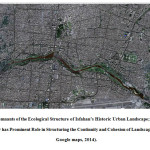 |
|
City growth and modernity- originated changes during the last four decades paved the way for landscape fragmentation and degradation of historical gardens adjacent to the historical region. The transition from the tradition to the modernity has been followed by destruction of Isfahan`s invaluable historical heritages, such as tributaries networks of river, which were recognized as urban rusty texture and eliminated through construction procedures to prepare bare lands for further urban structures (Fig.2).
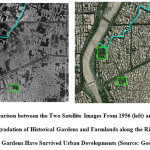 |
Figure 2: Comparison between the Two Satellite Images From 1956 (left) and 2010 (right) Shows the Degradation of Historical Gardens and Farmlands along the River Shore. Only Two Historical Gardens Have Survived Urban Developments (Source: Google maps, 2014). Click here to View figure |
City map of 1919 reveals weak emergence of complicated urban structure on northern parts. Historical regions of the city were surrounded by ecological structures of the farmlands and gardens. The river had its buffer and was separated from urban constructions by woodlands, farmlands and gardens (Fig.3).
Reviewing the satellite images of Isfahan City’s status quo in 2014 and detecting the ecological and historical changes throughout the years confirm rapid alteration and critical destruction of the landscape.
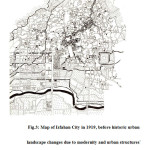 |
|
Unilateral approaches toward urban landscape design and planning and also inattentiveness to ecological structures, as backbones of landscape’s continuity and resistance, resulted in critical circumstances for decision- makers which is known as the challenge of conservation in remnant historical and natural urban landscapes. Moreover, there are some other restrictions that make it more challenging for planners to deal with new developments and residents` needs; namely: increasing economic value of residential spaces, different land tenures, increasing demand to development, social issues, global communication and resultant changes, ecological structure destruction etc (Fig.4).
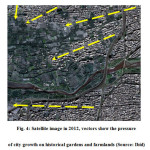 |
|
Introducing the significant values of historic urban landscapes, formed since archaic eras, and their interconnection with natural structures of the city helps people to understand their importance and the necessity of supporting and conserving these monuments. As a means of improving the preservation of these landscapes, facilitating public participation, motivating local communities, empowering cultural groups and introducing the region’s life history can be utilized as managerial measures.
Results
Following steps have commonly been applied in most conducted studies so far:
First
Mapping the existing historical city which helps to identify other overlaid cultural landscapes, through this step many other tangible or intangible patterns emerge
Second
Dignifying the historical cities by inviting investors to value and respect these places (Röhring, 2011)
Third
Development of design guidelines for existing interferences which are mostly new traditions or modern artificial patterns
According to aforementioned topics, several issues need to be taken into consideration in process of planning and design for historic urban landscapes regarding integrated environmental conservation paradigm. The issues include:
- Analysis of interrelationship between people and places over the time
- Identification and comprehension of changes in landscape values in order to apply them in landscape development plans
- The special interaction between nature and culture in different spatial and societal settings
- Application and integration of conservative systems’ principals and diverse managerial measures
- Preserving the universal values of historic urban landscapes
- Integrating native community needs and private or public tenure rights in managerial and conservation strategies
Discussions
As a result of this research, a gradual discontinuity is observable in ecological structure of the city. Administrative bodies currently strive for restoration and reconstruction of highly valuable historical constructions. Conservation of ecological structures is limited to varied measures by municipality.
In city development plans, urban planners and designers as in traditional methods, prepare an inventory of historical values and resources which seem to be substantial in historic urban landscape. This approach only covers the identification of elements in isolation and ignores ecological systems. Needless to mention that without taking ecological systems into consideration, it is not possible to have a rational judgment about adverse impacts of disturbances on landscape`s balance and resistance and also remedial measures for their sustainability and improvement.
It can be inferred from the results that each historical region and its surrounding setting need to be considered as an integrated entity. Sustainability and steadiness of that historical region depends on the interrelationships among the natural, physical and historical components. In this integrated approach all components must be taken into consideration and should not be ignored. As a significant factor, human activities need to be reflected in development plans and designs (Fig.5).
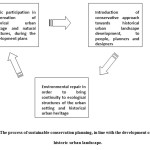 |
|
Also, the process of sustainable planning for Isfahan’s historic urban landscape can be suggested as the following diagram:
Hence, a comprehensive approach that relates all levels of landscape and consequently enforces its connectivity characteristic seems more suitable and reasonable for conservative planning of historic urban landscapes. Basic principles of historic urban landscape planning and development, conformed to conservative planning strategies are presented as following:
- Historical parts in cities are the spaces manifesting cultural productivity of the urban system; in fact, considering their functional values, they should be benchmarked as “hotspots” in planning and not as a resistance to non- historical parts, because the city itself has a historical essence.
- Historical parts of the city are a subset of a bigger system made up of natural and man- made environments and reveals the daily experiences of the citizens. The extensive spaces, enriched by historical and archeological values and the dynamic processes of improvement, are witness to the environmental capabilities of cities in formation of historical landscapes.
- Cities as a community- driven cultural expression add values to surrounding environment. In fact built spaces are the physical and visible result of social productivity. Hence, landscape evaluation standards need to take cultural- social costs of the new constructed regions into consideration.
Planning according to aforementioned principles introduce city as a historical entity and output of socially productive processes. Urban regions are part of a more extensive space which reinforces the continuous and dynamic procedures of development.
Since historical parts are dependent on the nature and its constituting elements such as buildings and spatial organization, each historical region and its surrounding setting, beyond the explicit intermediate spaces, should be taken as a whole to provide its balance and survival. This approach is totally different from last decades` perspectives which restricted historical cities to the boundaries of intermediate limits.
It should be emphasized that intrinsic heterogeneity is the characteristic of historic urban landscapes; hence the following issues need specific consideration during planning and design:
1. Cultural mapping as a tool for identifying the exact location of the historical regions on bigger scales.2. Environmental impact assessment that covers not only the natural aspects but also the cultural, social and visual aspects.
3. An integrated approach towards the planning of urban landscape development and modification of the economic development of the city.
This approach provides a modern framework for planning, design and management of historic urban landscapes.
The future of our historic urban landscape calls for mutual understanding between policy makers, urban planners, city developers, architects, conservationists, property owners, investors and concerned citizens, working together to preserve the urban heritage while considering the modernization and development of society in a culturally and historic sensitive manner, strengthening identity and social cohesion. An essential factor in the planning process is a timely recognition and formulation of opportunities and risks, in order to guarantee a well-balanced development and design process. The basis for all structural interventions is a comprehensive survey and analysis of the historic urban landscape as a way of expressing values and significance. Investigating the long-term effects and sustainability of the planned interventions is an integral part of the planning process and aims at protecting the historic fabric, building stock and context.
Finally, the development and implementation of a Management Plan for historic urban landscapes requires the participation of an interdisciplinary team of experts and professionals, as well as timely initiation of comprehensive public consultation.
References
- Akagawa, N., Heritage Conservation in Japan’s Cultural Diplomacy: Heritage, National Identity and National Interest, Routledge, New York. 2015.
- Ardalan, N. and Bakhtiar L., The sense of unity: the Sufi tradition in Persian architecture, The University of Chicago Press, Chicago. 1979.
- Bahrami B., and Agha Ebrahimi Samani F. The role of environmental data integration for specifying conservative buffer zone in cultural landscapes. International Journal on Technical and Physical Problems of Engineering. 2014;6:86-91.
- Cantacuzino, S., Can Isfahan Survive? Architectural Review. 1976;159:292-300.
- Chapuis M., Lydon A. , eds. Preserving our heritage, improving our environment, Belgium. 2009.
- English Nature, Annual Report (No.31), English Nature, Peterborough. 2009.
- Gaube, H. Iranian Cities, New York University, New York. 1978.
- Haghighat Bin, M. A., Steenbergen, M., eds. Sustainability of Isfahan’s landscape Design during Safavid Period, 2nd Int. Conf. on Landscape Architecture. 2009.
- Hassler U., Algreen-Ussin, G. eds. Cultural heritage and sustainable development in SUIT, SUIT Position. 2002;3:1-5.
- Jokilehto J. Notes on the definition and safeguarding of HUL, City & Time. 2010;4:41-51.
- Karimi K., Motamed N. The tale of two cities: Urban planning of the city Isfahan in the past and present, 4th International Space Syntax Symposium, London. 2003.
- Karimi K. Iranian Organic Cities Demystified; a unique urban experience or an organic city like others. Built Environment. 2002;3:187-202.
- O’Donnell P., Turner M. The Historic Urban Landscape Recommendation: A New UNESCO Tool for a Sustainable Future, Meeting of IFLA, Cape Town. 2012.
- Pauleit S., Breuste J. eds.Transformation of rural-urban cultural landscapes in Europe: Integrating approaches from ecological, socio-economic and planning perspectives, Landscape Online. 2010;20:1-10.
- Röhring A. Cultural landscape as action arena – an identity-based concept of regionbuilding”, Regional Studies Association Annual International Conference, Germani. 2011.
- Sartipipour M. Indigenous Housing of Villages 466 BAHRAMI & SAMANI, Curr. World Environ., Vol. 10(2), 456-466 (2015) in Markazi Province., International Journal of Humanities and Social Science. 2012;2:84-95.
- Smith J. Marrying the old with the new in historic urban landscapes, in Managing Historic Cities, edited by Ron van Oers and Sachiko Haraguchi, UNESCO World Heritage Centre. 2010;45-52.
- Stovel H. Approaches to Managing Urban Transformation for Historic Cities, UNESCO World Heritage Centre. 2008;103-120.
- Taylor K., Lennon J. Managing Cultural Landscapes (Key Issues in Cultural Heritage, Routledge, London. 2012.
- UNESCO, Convention for safeguarding of the intangible cultural heritage. Portal.unesco. org. 2003.
- UNESCO. Conservation of Architecture, Urban Areas, Nature & Landscape: Towards a Sustainable Survival of Cultural Landscape. Portal.unesco.org. 2011.
- UNESCO. Recommendation on the Historic Urban Landscape Programme and Budget for 2012-2013. Portal.unesco.org. 2012.
- Vural, Tugba S. Urban development of Bursa and Piccinato Plan. Urban development and urban planning culture of Bursa, Bursa: Osmangazi Municipality Publication. 2008.
- WHC. Managing the Historic Urban Landscape. Vienna Memorandum on World Heritage and Contemporary Architecture, Paris: UNESCO World Heritage Centre. 2005.
- Google maps, https://maps.google.com. 2014.







